Serie A returned with a bang this weekend as Gian Piero Gasperini returned to Genoa on Sunday and secured a welcome win for Atalanta against his former club. In a restless, entertaining encounter, Atalanta ran out 2-1 winners thanks to Duván Zapata’s late winner. This tactical analysis will look at the tactics of both teams, particularly their respective pressing systems and how they both looked to overcome those pressing schemes.
Lineups
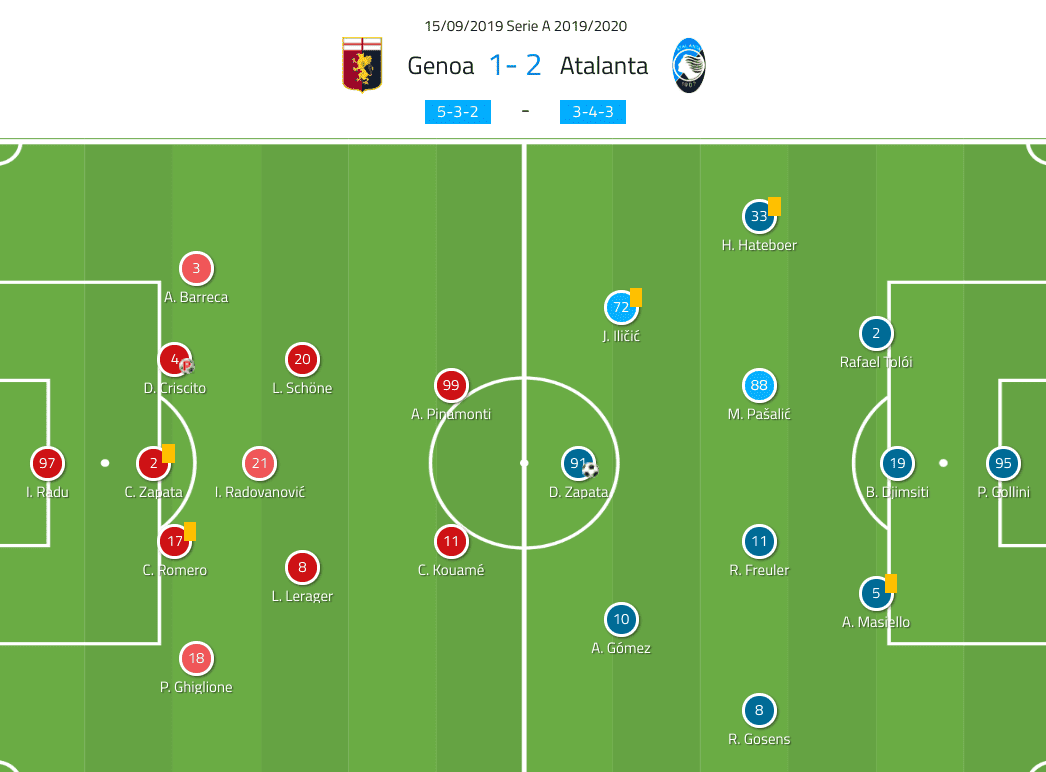
Aurelio Andreazzoli named the same team that defeated Fiorentina last time out which meant the encouraging strike partnership of Andrea Pinamonti and Christian Kouamé once again led the line for this Genoa bursting with energy. At the back, Cristian Zapata came up against his brother Duván.
Gasperini made one change from the team that narrowly lost to Torino last time out with Remo Freuler coming in for Marten De Roon. In attack, Luis Muriel once again found himself on the bench but he would come on and score the opener midway through the second half.
Tactical analysis: Genoa’s pressing and defensive issues
Genoa pressed with very clear man-orientations with the aim of stopping Atalanta’s effective build-up play. We can see this approach in the image below as all Genoa players mark an opponent. With Atalanta’s back-three, this meant Lukas Lerager was pushing up from midfield to mark Atalanta’s left-sided centre-back Andrea Masiello. If Lerager remained in midfield, Masiello or the central centre-back Berat Djimsiti would be left as a free man.
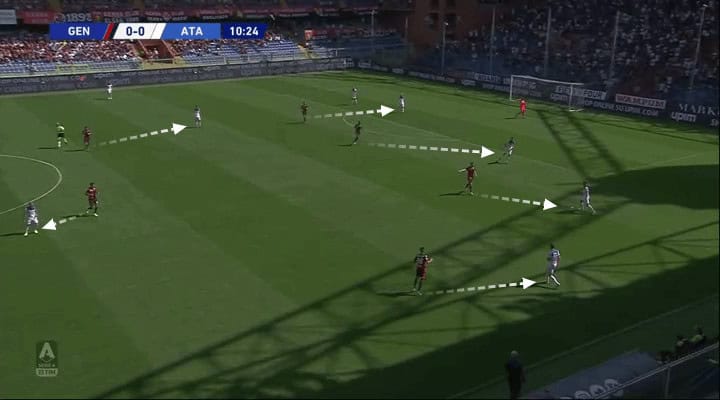
For Genoa, each player normally had a direct opponent to keep track of with the exception of Radovanović who usually sat in midfield and covered space. We can see him doing just that in the image below with Radovanović in the centre-circle. Lerager and Lasse Schöne then marked Atalanta’s two midfielders, leaving Djimsiti (yellow) as the free man for Atalanta. As we will see later, Atalanta managed to use this fact to their advantage when they looked to progress the ball.
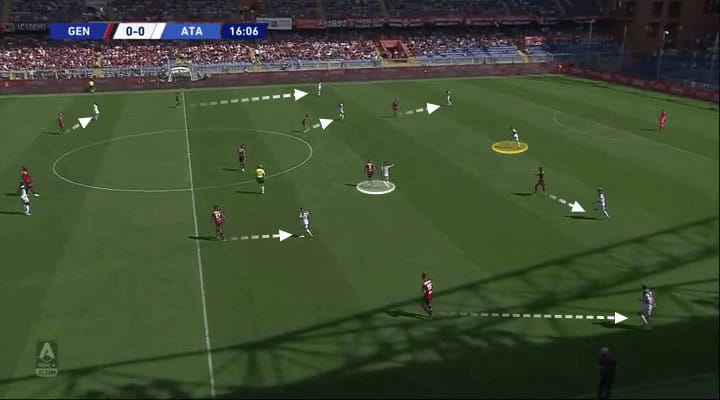
When defending deeper, Genoa moved into a slightly more zonal setup of 5-3-2. However, the dangers of man-orientated defending were evident on a number of occasions. The most glaring example is the one in the image below. Genoa defend in a 5-3-2 and Schöne on the left of their midfield three does not follow his fellow midfielders across to Genoa’s right. As Atalanta move the ball inside to Mario Pašalić, the Croatian is granted huge space outside Genoa’s box. He decides to pass into the box to the unmarked Robin Gosens, but Pašalić could easily have decided to shoot instead from a very dangerous position.
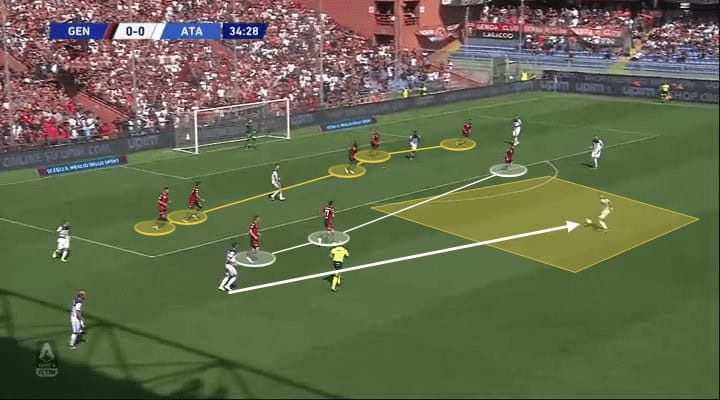
Genoa’s pressing was quite effective for the first 30 minutes especially, but then Atalanta’s quality in possession began to tire the home side out. It became increasingly difficult for the outer centre-backs to deal with the dropping movements of Alejandro Gómez and Josip Iličić which gave Atalanta more options in midfield as well as more time in possession for their best players.
Atalanta’s pressing and defensive issues
No one who knows about Gasperini will be surprised by the way Atalanta defended with their extreme man-orientations across the pitch. The image below gives us a good overview of how Atalanta looked to deal with Genoa’s attacking shape. The front three of Gómez, Zapata and Iličić pressed Genoa’s back-three while the midfield duo of Freuler and Pašalić marked Schöne and Radovanović. Down the sides, it was a straight wing-back battle between the two sets of wide players. Genoa’s numerical advantage in midfield prompted Masiello to leave the back-three and mark Lerager in midfield, leaving Djimsiti and Rafael Tolói two-vs-two with Kouamé and Pinamonti.
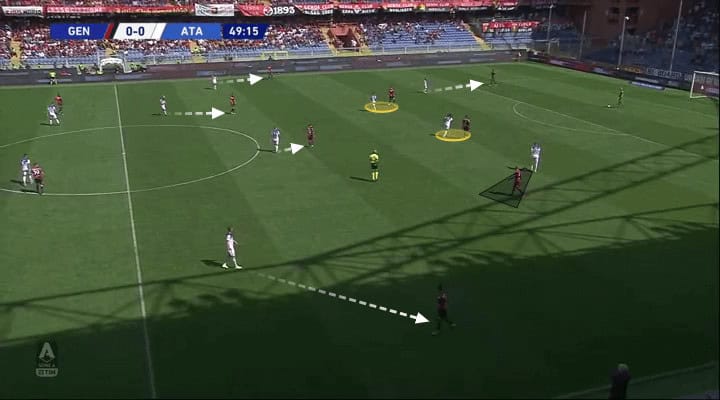
The image below is another example of Atalanta’s pressing scheme and has Masiello push into midfield to mark Lerager but the Italian is just out of shot in this image.
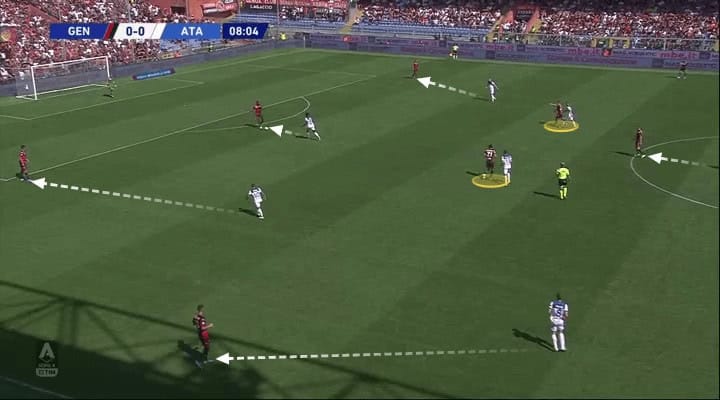
As mentioned in this analysis of Genoa’s tactics, Andreazzoli wants the left-sided centre-back Domenico Criscito to move into midfield when Genoa have goal-kicks. This is likely due to him providing a second pass option behind the opponent’s first line of pressure. We can see this setup in the image below as Criscito joins Ivan Radovanović in midfield as Genoa look to build from the back. Atalanta, however, mark every player in Genoa’s own third and force a long ball from the goalkeeper Ionuț Radu.
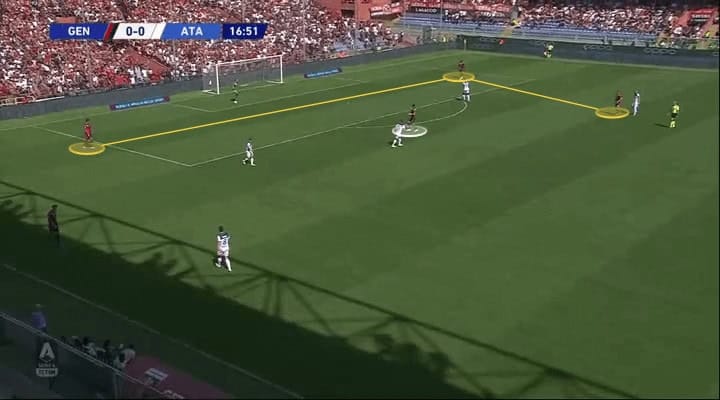
Despite Atalanta’s pressing working very efficiently and forcing Genoa to often go long, Genoa did manage to cause Atalanta some trouble and expose Atalanta’s man-orientated defending. The image below highlights such a situation when Genoa manage to get out of a tight situation on Atalanta’s left wing. The man-orientated nature of their defending has drawn both midfielders to the ball-side and left the centre totally vacant. This is the space Genoa manage to break into with Schöne receiving and then progressing the ball.
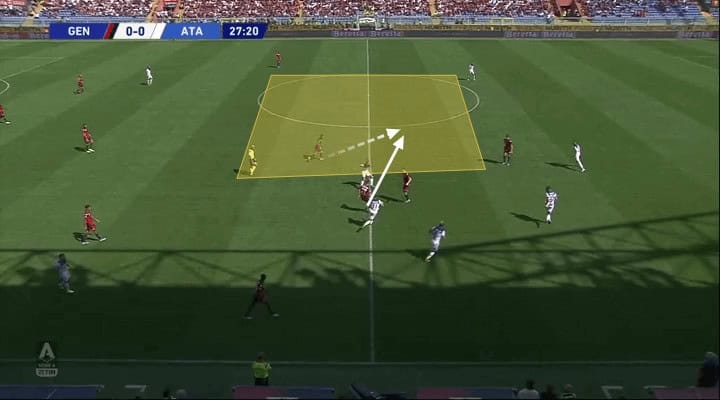
The image below is taken a few seconds later when Genoa have worked the ball back to their right and Kouamé threads the ball into the number ten space where the shot is blocked at the last minute. Here, we can see that Atalanta, much like Genoa, failed to close the ten space as they were too focused on their marking which was exploited by the opposition. This, obviously, is one of the main deficiencies of a man-orientated defensive style- namely that crucial spaces might be left uncovered and can be exploited by the opponent.
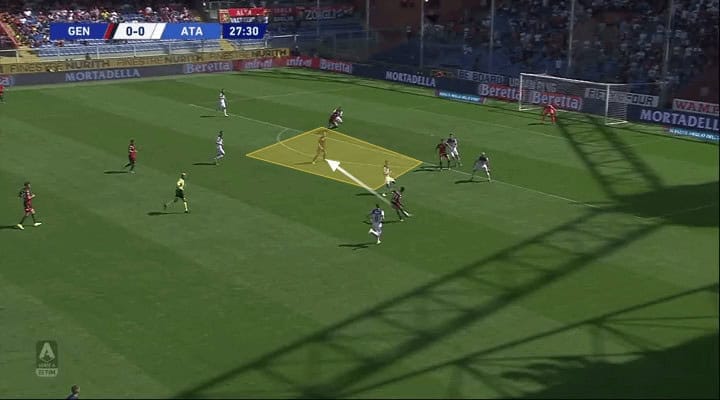
How Genoa looked to overcome Atalanta’s press
Genoa’s plan was clear: they wanted to bypass midfield and play straight into their strikers. This either meant lob the ball over Atlanta’s defence or into the body of a striker. It was a smart move given Atalanta’s strong pressing in the middle third and something that seemed to suit their front two of Kouamé and Pinamonti. The image below highlights one of these situations as Criscito plays the ball over the top into the run of Pinamonti.
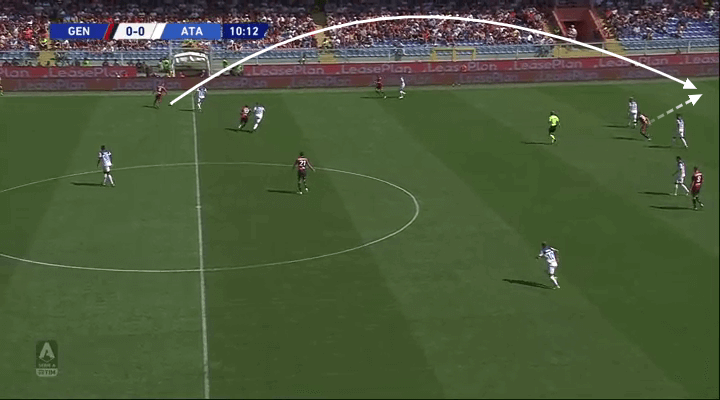
The Genoa players often played this type of pass by nature, seemingly off the cuff, with the hope of trying to catch Atalanta out. The image below highlights such a situation as the right wing-back Paolo Ghiglione plays the ball the first time and looks to find Pinamonti or Kouamé in behind Atalanta’s defence. This suggests that first time passes into depth were definitely something Genoa had talked about beforehand.
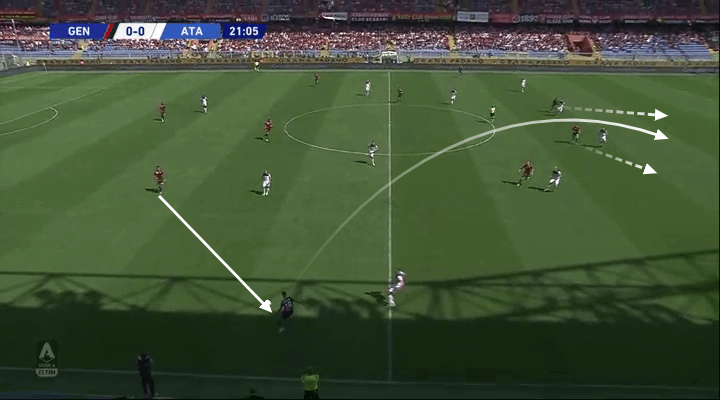
As mentioned, Genoa also looked to bypass Atalanta’s midfield with passes into the feet or bodies of their strikers. In the image below, Criscito plays such a pass into the feet of Kouamé which allows Genoa to progress the ball beyond Atalanta’s midfield.
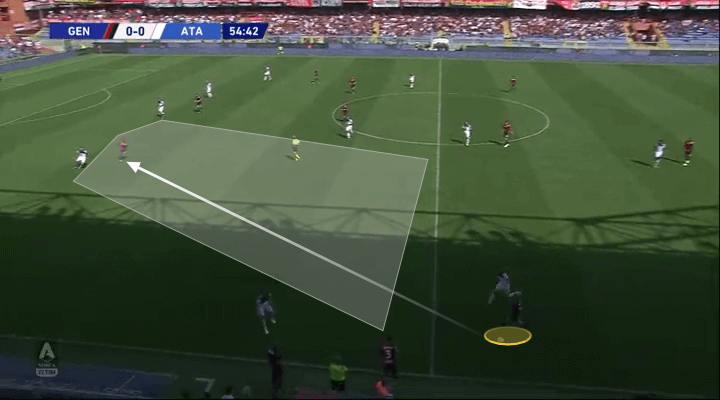
The front two Genoa have right now is extremely exciting given what they bring to the team in the overall play. Kouamé in particular looks fantastic at the moment and was impressive in his movements and touches on Sunday. The image below highlights one of the occasions when Genoa managed to progress the ball centrally into him. Radovanović first plays the ball through the lines to the forward.
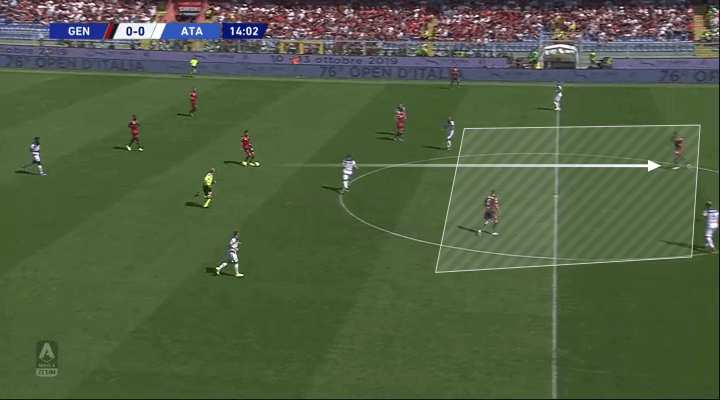
Kouamé immediately then flicks the ball on towards Pinamonti who is in 1 vs 1 with Djimsiti. This is a good time to note the aggressive positioning of Atalanta’s outer centre-backs. Tolói has followed Kouamé into midfield and Masiello is pushing on to mark Lerager. Kouamé instantly spins around and looks to attack the space behind Djimsiti and Pinamonti (white circle). On this occasion, Pinamonti fails to send Kouamé through on goal, but the intention and the understanding they have together are cause for optimism at Genoa.
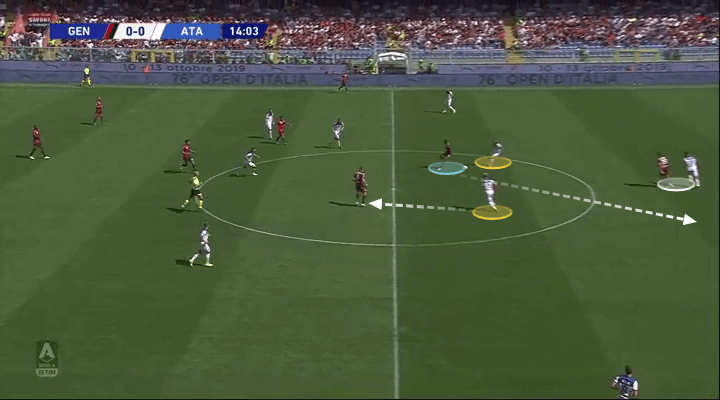
How Atalanta looked to overcome Genoa’s press
As mentioned previously, Atalanta usually had a spare man at the back when building attacks. They used this numerical advantage well to progress the ball on a number of occasions. The image below highlights one of the methods they used to progress the ball. Here, Djimsiti is the spare man and moves into midfield to make himself a pass option for Gosens who is pressed intensely by Ghiglione. Djimsiti can receive, face forward and progress the attack by giving Atalanta a spare man in midfield.

The other method Atalanta used to progress the ball involved Masiello stepping into midfield with the ball. As you can see below, Genoa’s midfield three (yellow circles) were busy marking Atalanta’s midfielders while the front two was concerned with Tolói and Djimsiti. This left Masiello as the spare man. Here, he receives the ball and runs with it into the highlighted space to progress the attack for the visitors.
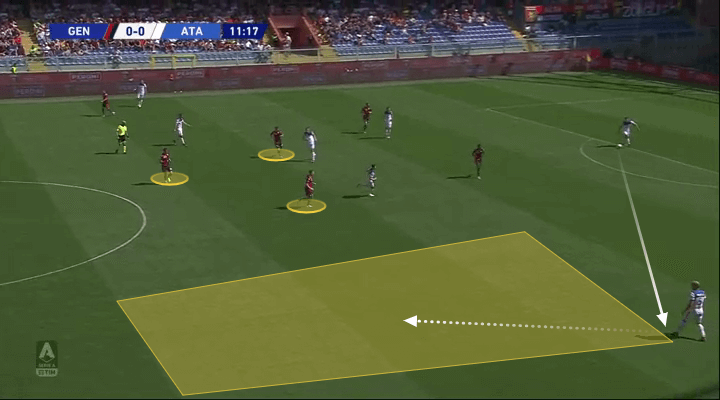
When Masiello stepped out with the ball, Gómez often made movements towards him to receive. As such, Genoa’s right-sided centre-back Cristian Romero followed his countryman and left a huge space open in Genoa’s defence. This space was then attacked by Zapata, who always had his brother after him, and Masiello would then look to find the striker in that inside-left channel with passes into depth.
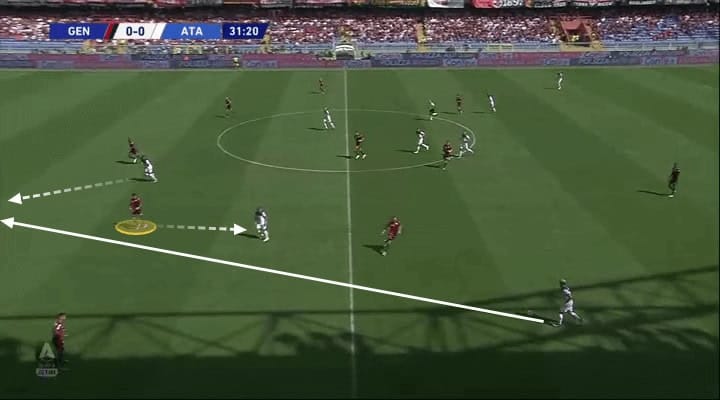
The use of centre-backs stepping out of Atalanta’s defence proved successful and was one of the reasons behind their ability to gain control of possession after a frantic start to the game.
Conclusion
In a very even game, Atalanta were the better team and deservedly left with three points. Genoa ran them close, however, which indicates Andreazzoli’s team can look at the rest of the season with optimism after a very good start from their tough opening three games. Atalanta will have felt unlucky after the loss against Torino, so the win here was definitely welcome for La Dea. Already on Wednesday, they face a new challenge as they prepare for their first-ever Champions League game away at Dinamo Zagreb.

If you love tactical analysis, then you’ll love the digital magazines from totalfootballanalysis.com – a guaranteed 100+ pages of pure tactical analysis covering topics from the Premier League, Serie A, La Liga, Bundesliga and many, many more. Buy your copy of the August issue for just ₤4.99 here.




Comments